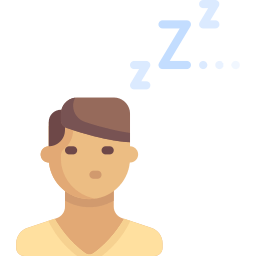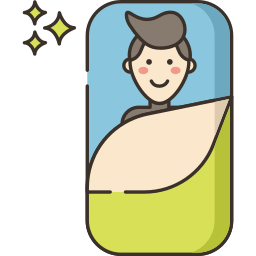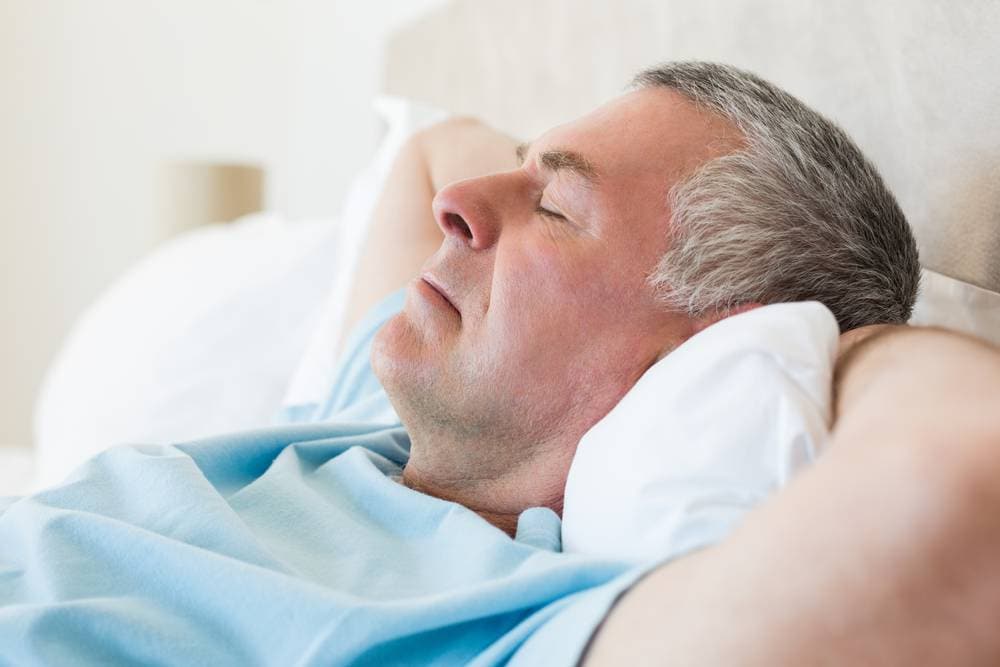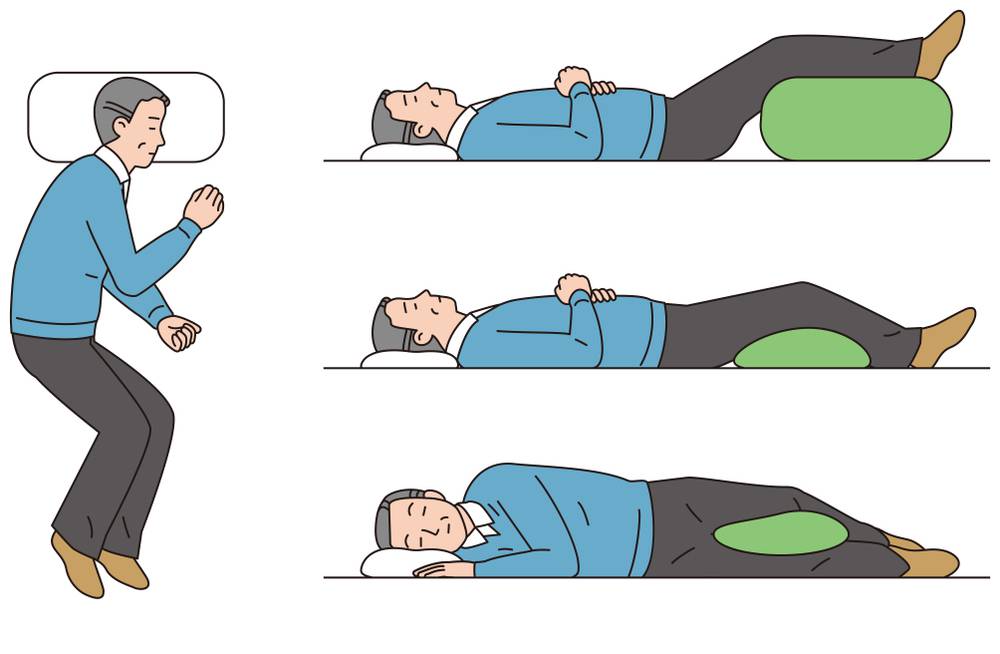 Why Your Sleeping Position Matters
Why Your Sleeping Position Matters The Benefits of Sleeping on Your Back
The Benefits of Sleeping on Your Back The Downsides of Sleeping on Your Back
The Downsides of Sleeping on Your Back The Right Mattress For Back Sleepers
The Right Mattress For Back Sleepers How to Sleep on Your Back
How to Sleep on Your Back Quick Steps For Training Yourself
Quick Steps For Training Yourself

For a long time, sleeping on your back has been seen as the default sleeping position. However, it’s a different matter in practice, and only around 10 to 15 percent of people sleep in this position. Most people tend to sleep on their side, and the fetal position has been identified as one of the best.
Still, there are benefits to sleeping on your back that the fetal position doesn’t offer, especially if you have issues with pain and a lot of experts consider it to be the best position. But, if you’re used to a different position, training yourself to sleep on your back can be a chore
The best part?
In this topic, I will show you how to sleep on your back and all the information about sleeping position.
Why Your Sleeping Position Matters

First off, let me discuss this because it is important. While I certainly wish that were true, it is simply not the case.
Plenty of people don’t think their sleep position matters as long as they feel comfortable in it.
While I certainly wish that were true, it is simply not the case. Some sleeping positions are simply better than others, and certain ones can even be harmful to you in the long term. It greatly impacts your health.
One thing that your sleeping position greatly impacts is your spine. If it isn’t aligned properly, the stress can lead to many different conditions, like a slipped disc or dislocated vertebrae and more.
Of course, your spine is connected to other parts of your skeleton so the strain put on it can easily transfer to other parts – your shoulders, your neck, your hips and more.
Sleeping on your stomach is probably the worst position when it comes to the health of your spine. There’s practically no way for your spine to align properly when you’re sleeping like that, and your neck is constantly twisted to one side, putting it under a lot of stress.
After a long period of sleeping in such a position, your health will be under a great deal of risk.
Another way in which your sleeping position impacts your health is the breathing. If you’re not positioned properly, you might have trouble breathing during sleep, reducing the oxygen flow to your brain and the rest of your body. If you’re feeling tired after sleeping for a long time, you might have problems with breathing during sleep.
Again, sleeping on your stomach is the worst position. You can’t breathe properly since there is no way for your lungs and diaphragm to move properly. You’re squishing your stomach and internal organs unnaturally and leaving little space for your chest to expand.
Truly, sleeping on your stomach is the worst sleeping position not only for these reasons but plenty more in addition to that. You can even irritate your nerves and get permanent spinal nerve damage because of it.
On the literal flip-side, sleeping on your back is probably the best position, and I’ll go deeper into the why and how of that in the next section.
The Benefits of Sleeping on Your Back

Before you decide if you want to start sleeping on your back regularly, you should be aware of what you gain and what you lose by doing that. While there are some undeniable benefits to sleeping on your back, there are also plenty of downsides that impact some people more than others.
First, I’ll start with some of the benefits that sleeping on your back provides.
1Easing Back and Neck Pain
The greatest benefit that you gain from sleeping on your back is pain relief. If you have problems with chronic back, neck and head pain, this position is the best for dealing with it. But why and how does it help?
It might seem a bit counterintuitive – sleeping on your back makes your back hurt less? Well, it does, and the reason for that comes from the alignment of your spine in that position.
You see, when you’re sleeping on your back your head, spine, and neck are able to maintain a neutral position.
This position also eases the tension in your back and neck muscles, reducing any pain that might be present because of them straining during sleep.
To achieve the best results, take care of the following:
- Fill any gaps between you and the mattress with pillows
- Make sure your hips, shoulders and ears are aligned
- Don’t twist your head to the side
While this is the main, major benefit of sleeping on your back, there are others as well.
2Reducing Acid Reflux
People who have digestive tract issues often have to deal with acid reflux, and it can stop them from sleeping at night. It’s a two-way street, though, since bad sleep can make acid reflux worse and it becomes a vicious and exhaustive cycle.
However, sleeping on your back can help immensely when dealing with gastrointestinal problems. But how does it make things better?
Well, you see, when your stomach is situated below your esophagus, like when sleeping on your back with your head elevated, it’s much harder for acid or food to come back up.
While this position won’t completely get rid of acid reflux, it will make things significantly better for most people who suffer from it.
3Fewer Wrinkles
Yes, it’s true
Sleeping on your back will help you look more beautiful for a longer time. It seems ridiculous, but there’s some solid reasoning behind it.
One of the main reasons this sleeping position helps with your face wrinkles is because it’s the only one that doesn’t smush your face into the pillow.
People who constantly sleep on one side of the face will have more wrinkles on that side. Sleeping on your back also causes your face to swell less, leading to less puffiness around the eyes in the morning.
It also helps your skin regenerate better since dead skin cells can fall off more easily if your face isn’t buried in the pillow. You can also apply beauty products to your face without any worry that they will end up on your pillow once you fall asleep.
The Downsides of Sleeping on Your Back

Before you decide if you want to start sleeping on your back regularly, you should be aware of what you gain and what you lose by doing that. While there are some undeniable benefits to sleeping on your back, there are also plenty of downsides that impact some people more than others.
First, I’ll start with some of the benefits that sleeping on your back provides.
As you would expect, there are also some bad things about sleeping on your back. Because of that, it’s not recommended for everyone – just most people. But, if you can deal with the downsides, you should still do it.
Here’s what some of the major downsides are.
For people who snore, this position is one of the worst, if not the worst. This is probably due to the effect gravity has on your upper airways and your tongue, which fall back into your throat, causing you to snore.
Even if you’re not a snorer, sleeping on your back might cause the problem to occur and in that case, you should definitely switch-up your sleeping position. If you’re already snoring, this will exacerbate the condition, so sleeping on your back is not recommended.
Sleep apnea is a condition in which your upper airways are constantly blocked while you’re sleeping, resulting in a reduced intake of air, or even periodical choking and lack of breathing. You don’t notice any of this, though.
This condition is more common than one might think and it often goes undiagnosed. However, it does affect you severely, causing you to have worse sleep quality and possibly leading to many other conditions like heart attack and cancer.
Sleeping on your back, especially if your head isn’t elevated, is the worst position when you have sleep apnea, for the same reasons that it’s bad for snoring. Your airways become obstructed more easily, and the condition can become more severe.
If you suffer from this condition, you should most likely avoid sleeping on your back. Instead, follow some of these guidelines:
- Sleep on your side to stop your airways from collapsing
- Elevate your head so your tongue doesn’t block your airways
- Properly ventilate the room you’re sleeping in
But, you might not even know you have sleep apnea. The most common signs that you have sleep apnea include:
- Snoring
- Shallow breathing or lack of breathing during sleep
- Excessive daytime sleepiness
- Constant tiredness
- Dry mouth when waking
- Excessive nighttime urination
Of course, these symptoms can be caused by other conditions, but you should go and get yourself checked out anyway if you suspect you might have sleep apnea.
Treatment options are usually easy and may include:
- Machines for assisted breathing
- Lifestyle changes
- Corrective surgery
If you’re pregnant, sleeping on your back is a complete no-go. The reason for this is that it can cause bad blood circulation and that can be extremely harmful to the baby and make it malnourished.
While sleeping on your back is good for problems with back and neck pain – something that pregnant women typically suffer from – you still shouldn’t be doing it. Just sleep on your side, no matter how uncomfortable it may be – it’s the best thing you can do for your baby.
The Right Mattress For Back Sleepers

One thing that helped me a lot with training myself to sleep on my back was my mattress. Since sleeping on your back is hard already, a soft, worn-out mattress makes things even worse. So, I got the best mattress for back sleepers that I could find.
Such a mattress should be:
- Firm but not too hard (medium firm is good for people of average weight)
- Supportive
- Made out of memory foam or latex
- Durable
- Breathable
Try to buy a new mattress though, since older and used mattresses are usually not supportive enough and are bad for people who sleep on their back.
How to Sleep on Your Back

Before you decide if you want to start sleeping on your back regularly, you should be aware of what you gain and what you lose by doing that. While there are some undeniable benefits to sleeping on your back, there are also plenty of downsides that impact some people more than others.
First, I’ll start with some of the benefits that sleeping on your back provides.
For a lot of people, sleeping on their back can be uncomfortable or feel unnatural, so they can’t fall asleep in that position. Others might have no trouble falling asleep while lying on their back, but will toss and turn around in their sleep and will spend most of the night on their side or stomach.
Either way, it’s not easy training yourself to sleep on your back. I know, I tried to do it, and it took a while until I succeeded. Now I’ll share what I learned and what methods I used to achieve it.
Quick Steps For Training Yourself

Before you decide if you want to start sleeping on your back regularly, you should be aware of what you gain and what you lose by doing that. While there are some undeniable benefits to sleeping on your back, there are also plenty of downsides that impact some people more than others.
First, I’ll start with some of the benefits that sleeping on your back provides.
Here’s the whole process in a few short steps:
- Lay on your back
- Place pillows for support as needed (under your knees, under the lower back)
- Place your hands above your head or at your sides
- Spread your legs out
- Make sure that you stay in that position
Next, I’ll go into a bit more detail.
1Tips and Tricks
Here are a few things I learned about making this position more comfortable for sleeping that you should probably know before you try it out.
- Pillows are helpful – Use as many positional pillows as you need to get more comfortable. Place them where you feel is necessary, though the best positions might be at your lower back or below your knees. You can also buy special pillows created for providing support.
- Don’t fall back into old habits – Every time you start to roll to the side, force yourself to return to sleeping on your back. Just keep doing it every time you catch yourself getting into another position and persist with it.
- Get the right kind of pillow – Sleeping on your back won’t do you much good unless you got a proper pillow to go with it. Malleable, soft pillows are the best. Try buckwheat pillows, for example.
- Make sure the temperature is right – Since you’ll be using additional pillows or bedding for additional support you should make sure that your room temperature is right. If not, you’ll probably be too hot and throw off the additional support in your sleep, which is not what you want. Set the thermostat to a reasonable temperature according to the time of year.
Now, I’ll move onto the specifics of how to train yourself to sleep on your back – or at least some of the methods that worked for me.
2My Story
At first, sleeping on my back was slightly uncomfortable, and I couldn’t fall asleep easily. So, I tried using some pillows to make my position more comfortable.
- First, I tried to put them on my sides, between my body and my arms but that quickly became uncomfortable and too hot
- After a lot of adjusting and trying many different positions, I stuck to having a pillow beneath my knees and another one beneath my shoulder blades. That seemed to work for me, at least for the time being.
- It still took me a few hours to fall asleep and, once I woke up, I was on my side. So, that didn’t work as well as I thought.
- The next night was roughly the same, so the night after that I tried to do something radical and a bit stupid-sounding. I bought a pack of tennis balls and put two under the mattress, one on each side of me.
- That way, each time I turned to my side, even if I were asleep, I would have a painful reminder to stay on my back.
- That night was not a good one. I barely got any sleep at all, but I was on my back for most of it, so I kept at it.
- Another problem I had the next night was – what to do with my arms? Keeping them at my sides was a bit uncomfortable. Putting them on my chest made me feel like I was a dead body at a funeral, so that was not good. In the end, I settled for keeping them above my head, on the pillow.
- For the next few nights the tennis balls kept me honest, and I was able to keep sleeping on my back for most of it. After a few weeks of that, I removed the tennis balls, and I found that I was still able to keep sleeping on my back. I wasn’t turning to my side during sleep, and I was waking up on my back.
I still had some problems with comfort from time to time, but they went away after a while, and now I can sleep on my back all the time. It has done wonders for my back pain, and I’m feeling a lot better because of it.
Conclusion
So, that’s almost everything I could say on the topic of how to sleep on your back. I gave you all the info I could muster and shared my experience of trying to correct my bad habits and start sleeping on my back regularly. As you can see, I succeeded, and I hope you will as well!
I would like to thank you all for reading this article, and I sincerely hope it was helpful to you and that you had as much fun reading it as I had writing it. Though trying to train myself into sleeping on my back was significantly less fun, let me tell you that. Still, it was worth it, since my back and hip feel a lot better since then.
Until next time I wish you a good night’s sleep!
















